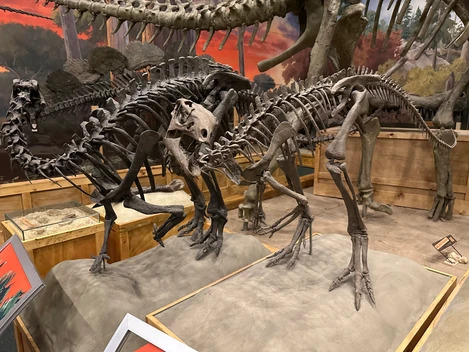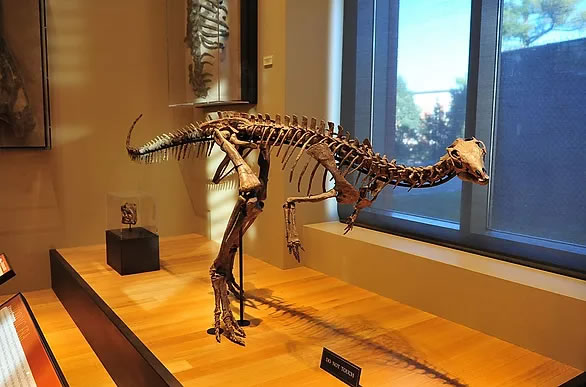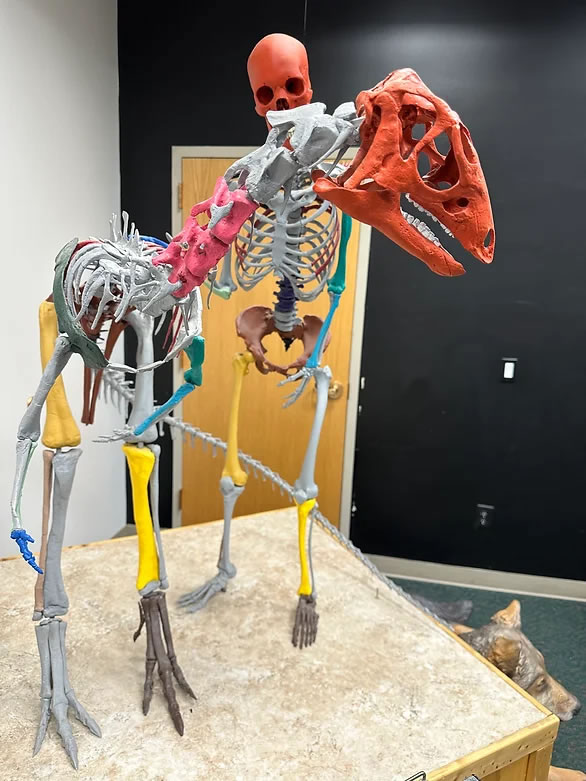
Dem bones, dem bones, dem DRY-osaurus bones!
John Michalski is a graduate from the University of Wisconsin, Milwaukee with a bachelor’s degree in geology. Currently he is working on achieving a masters of science degree at Utah State University, aiming for a career in vertebrate paleontology. He has been passionate about dinosaurs since he could walk and talk, and loves to discuss and educate others about paleontology and prehistoric life.
The late Jurassic period was a time of great opportunity and prosperity for the dinosaurs. Often described as their golden age, this period in Earth’s history saw the dinosaurs take full advantage of their roles as the masters of the planet’s many terrestrial ecosystems. In particular, a great variety of dinosaurs called western North America their stomping grounds. Giant long-necked sauropods such as Camarasaurus, Apatosaurus, and Diplodocus foraged alongside the plated Stegosaurus and Hesperosaurus, all vigilant for the hungry eyes of such great predators as Allosaurus, Ceratosaurus, and Torvosaurus.
But as with every ecosystem, smaller dinosaurs roamed amid these famous giants, their existence no less valuable in understanding their lost world. One of these was Dryosaurus, the “tree lizard.”
o Dryosaurus was a genus of dryosaurid ornithopod dinosaur from the late Jurassic of western North America. It has been discovered in Colorado, Wyoming, and Utah within the Morrison formation, with remains dating to the Kimmeridgian and Tithonian stages of the late Jurassic, from 156.3 million (Trujilo et al., 2006) to 146.8 million years ago (Bilbey, 1998).
o Dryosaurus was one of the smaller dinosaurs of its time, with adults weighing at a suggested range of 114 to 164 kilograms (Foster, 2020). But it wasn’t the only small dinosaur around. It shared its environment with other ornithopods, including Nanosaurus, a smaller dinosaur that resembled Dryosaurus in appearance, and Camptosaurus, a larger contemporary ornithopod. Fruitadens was a small heterodontosaur, a group of dinosaurs known for possessing different kinds of teeth. It is currently known only from fragmentary fossils (Butler, 2010). Among the theropods that shared its environment, we have Ornitholestes, Coelurus, Tanycolagreus and the small tyrannosauroid Stokesosaurus. These weighed in on the smaller scale of meat-eating dinosaurs. Although some likely preyed on small insects, mammals, and reptiles, theropods like Tanycolagreus may have been big enough to hunt Dryosaurus. Even the very biggest of the Morrison’s theropods wouldn’t have been above chasing down a soft, juicy Dryosaurus to snack on if they could get the drop on it. But that’s the thing: if they couldn’t ambush it properly, they had better enjoy eating whatever dust they choked on as the Dryosaurus sped off to live another day.

I don’t always drink martinis, but when I do, I like them Dry-osaurus.
o Hundreds of Dryosaurus remains have been found in sites near Uravan and Fruita, Colorado, all varying in age. This gives us good material for ontogenetic research. Ontogeny is the study of an animal’s growth stages from birth to adulthood. A baby Dryosaurus found at Dinosaur National Monument displays a shortened muzzle and proportionally larger eyes than in older individuals. As they matured, young Dryosaurus snouts would have lengthened, while their eyes would have become proportionally smaller (Foster, 2020).
o The name Dryosaurus means “tree lizard,” derived from the Greek dryas (meaning tree or oak) and was based on the notion the dinosaur lived in a forested habitat. Ecologically this isn’t too far off. The Brushy Basin member of the Morrison formation, where Dryosaurus has been discovered, has been interpreted as a fluvial-lacustrine environment, which would have supported lakes fed by local streams (Bell, 1986). This would have helped support a wide variety of plant life. Palaeobotanical research interprets the presence of habitats such as tree fern forests and prairies made up of conventional ferns, with araucaria trees dotting the plains (Carpenter, 2006). Dryosaurus has been suggested to have fed on low growing vegetation (Foster, 2020).

In Candyland, humans keep Dryosaurus as pets! The sidelined canid is clearly
miffed! Actually, this display uses color-coded bones to show comparative anatomy at
work. The dire wolf in the corner awaits installation in the Park.
o The earliest known remains of Dryosaurus were found in 1876 by Samuel Wendell Willston in Wyoming, and initially named by Othniel Charles Marsh as Laosaurusaltus in 1878 (Marsh, 1878). Later, in 1894, Marsh would lump Laosaurus into the newly coined genus, Dryosaurus. Curiously enough, the type species (in which the species name of a genus is permanently associated with) is still Laosaurus altus, with the combinatio nova (new combination in Latin) being Dryosaurus altus (Marsh, 1894). A second species, Dryosaurus elderae, was proposed by paleontologists Ken Carpenter and Peter Galton in 2018 based on material found in Utah (Carpenter and Galton, 2018).
o The Dinosaur Park and Stewart Museum both include representations of Dryosaurus. Our cast skeletons are based on material found in Wyoming by Western Paleontological Laboratories. You can compare them with our Camptosaurus skeleton to learn more about their respective survival strategies and ecological roles—for example, if you compare the structure of their legs, can you find out which one was faster? Ask one of our docents to learn more. Keep a sharp eye out for original Dryosaurus fossil bones in the specimen cases as well. The sculpture, located on the western side of the Park, is based on older art, so it has a tail-dragging posture and some proportional differences. However, its pose does approximate an alert posture Dryosaurus may have taken if it needed a better view of its surroundings.

It’s unseasonably cold in the Mesozoic this January, but Dryosaurus doesn’t seem to mind!
References:
Bell, T. E. (1986). Deposition and diagenesis of the Brushy Basin Member and upper part of the Westwater Canyon Member of the Morrison Formation, San Juan Basin, New Mexico.
Bilbey, S. A. (1998). Cleveland-Lloyd Dinosaur Quarry-age, stratigraphy and depositional environments. The Morrison Formation: an interdisciplinary study, 87-120.
Butler, R. J., Galton, P. M., Porro, L. B., Chiappe, L. M., Henderson, D. M., & Erickson, G. M. (2010). Lower limits of ornithischian dinosaur body size inferred from a new Upper Jurassic heterodontosaurid from North America. Proceedings of the Royal Society B: Biological Sciences, 277(1680), 375-381.
Carpenter, K. (2006). Biggest of the big: a critical re-evaluation of the mega-sauropod Amphicoelias fragillimus Cope, 1878. New Mexico Museum of Natural History and Science Bulletin, 36, 131-137.
Foster, J. (2020). Jurassic West: the dinosaurs of the Morrison Formation and their world. Indiana University Press.
Marsh, O. C. (1878). Principal characters of American Jurassic dinosaurs. American Journal of Science, 3(95), 411-416.
Marsh, O. C. (1894). The typical ornithopoda of the American jurassic. American Journal of Science, 3(283), 85-90.
Trujillo, K., Chamberlain, K., & Strickland, A. (2006). Oxfordian Park: U/Pb ages from SHRIMP analysis for the Upper Jurassic Morrison Formation of southeastern Wyoming with implications for biostratigraphic correlations. Journal of Vertebrate Paleontology, 26, 1-152.
